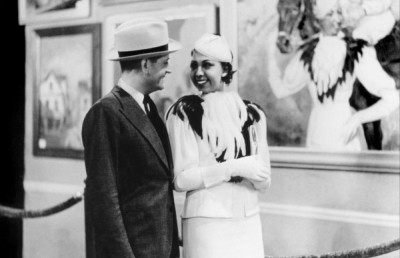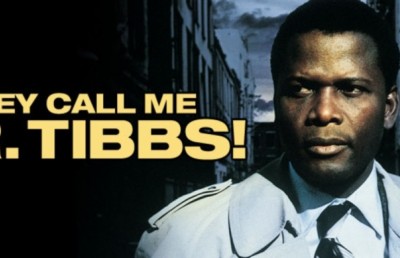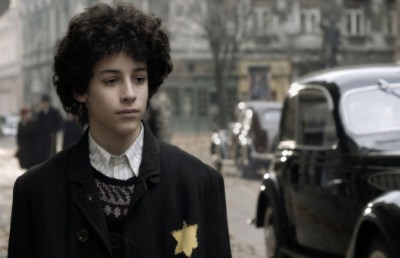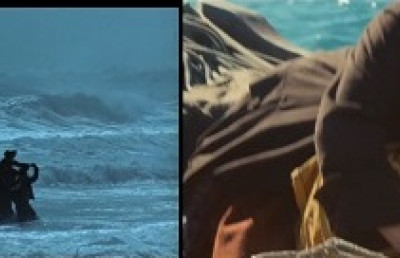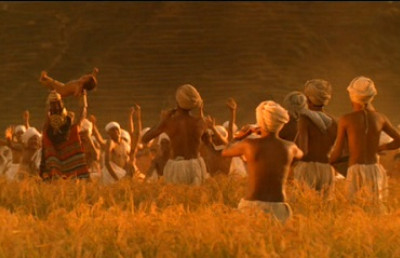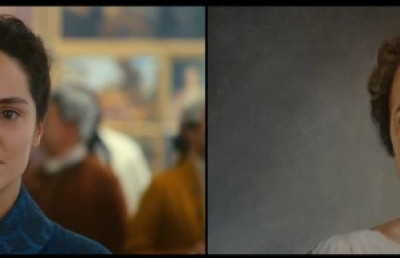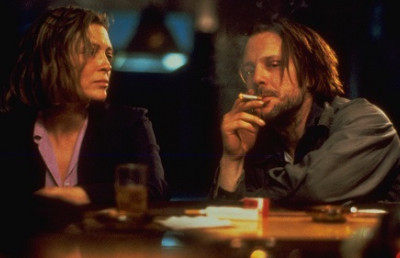Of Race, Representation and Responsibility in Jenni Olson’s Afro Promo
From Poiter to Blaxploitation
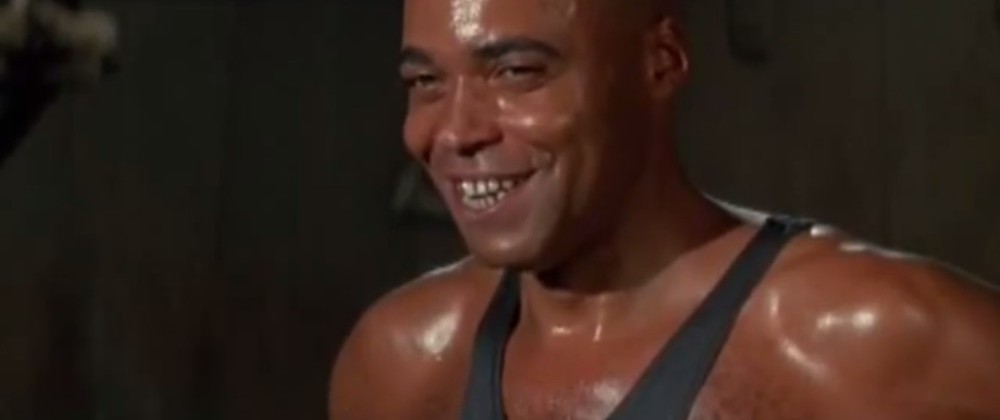
This mule ain’t from Moscow,
This mule ain’t from the South,
But this mule’s had some learning,
Mostly mouth-to-mouth.
This mule could be called stubborn, and lazy,
But in a clever sort of way,
This mule could be working, and waiting,
Learning, and planning, for a safer kind of day […] [1]
Charles Mingus, 1963.
Seated in Cinema du Parc’s #3 theatre awaiting the beginning of Afro Promo [1997) (Curator Jenni Olson’s collection of Black American Cinema Trailers, 1946 – 1976), I pondered whimsically: ‘Would there be trailers for coming attractions before this film of trailers?’ But as the presentation began, my line of inquiry shifted swiftly: What is implied in these ‘black movies’ (and trailers) of mid-20th Century America; what is the significance of the trailer form and its collection in this context; who is re-representing this representation of blacks in American cinema; (and perhaps more disturbingly) what, exactly, is the exclusively white audience laughing at? Furthermore as the piece is not purely a collection of trailers, but also serves to address a particularly socially-charged and sensitive subject, the work stirs larger issues of race, representation and the responsibility of American cinema to the continued formulation of socio-cultural identities.
Before initiating this investigation, a strong responsibility is felt to examine my own curiosity in the subject, and to place these intentions within context. Initially, my interests lay in the trailer form, which was my preliminary attraction to Afro Promo. Still, there is an obviously glaring incongruity amid a white, Canadian male analyzing the experience of existing upon the margins – at least as far as race and class are concerned. The question could be posed: ‘Whose business is it to launch a deconstruction of issues that are older, and seeded more deeply in a national identity than familiar personal reflections?’ Though in modest defense, informed by a social conscience, and personally, being of Ukrainian descent (a nation, like so many others, that has endured colonization, genocide), I feel confident in my ability and intention for the purposes of this analysis – to sensitively navigate within on-going racial and cultural discourses, while investigating the relative effectiveness of the work at hand.
Afro Promo is a collection of over 30 trailers for black American film – those starring, produced by, or aimed toward an African-American market – and traversing its integral period. Its composites range generically from Sport, Musical, Biopic and Drama, to Comedy, Action and Blaxploitation. On the surface, it appears as a kitschy, nostalgic compendium, however, emerging beneath is an aggressive voice in the social discourse surrounding Black film history in the U.S. The work acts as a magnification of slanted industrial production policies, and offers insight into the intended multi-racial audiences’ reception of popular African-American cinema during the mid-20th Century.
The film opens with a cycle of trailers including The Harlem Globetrotters [1951), and St. Louis Blues [1958), works which imply – both to black and white audiences – a pacification, domestication and deracination of black American social experience. For both trailers, the filmic subject is of sanctioned black cultural activity (i.e. basketball, jazz) as permissible by a patriarchal white society, predicated upon a provision of ultimate entertainment of the white spectator vis-à-vis empowerment of the black. In the trailer for The Harlem Globetrotters, happy-go-lucky players are depicted as obediently receiving instruction from their suspiciously white coach; St. Louis Blues is an apparent attempt to demystify and diffuse black contributions to the American musical landscape, meanwhile reinforcing exoticism and concepts of otherness. [2]
Gladstone L. Yearwood notes that during this period, and despite NAACP-led pressure on Hollywood representations: “[…] blacks remained marginalized on the fringes of the film industry, and there still was little meaningful reformulation of the limited filmic signification that had become commonplace […].” [3] According to reviewer Gary Morris, this signification “[…] consistently countered the growing concepts of black pride and power with a virtual army of self-sacrificing mammy figures (both male and female) […] ‘great black hopes,’ and the Good Negro […].” [4] This is reflected in the ensuing trailers, for In the Heat of the Night (1967), The Great White Hope (1970), and Sounder (1972). Each of these films categorically exemplify the culturally hegemonic assimilation of black archetypes, at once sanitized and packaged for sale by Hollywood studios. [5]
The latter period of the mid-1970’s (as exemplified in Afro Promo by a cycle of promos for Blaxploitation films), is considered a phase of altering attitudes in the U.S. toward segments traditionally marginalized. Widespread social activism reveals itself symptomatically in filmic narratives of race and gender-based inversion, often manifested in revenge narratives, directed upon oppressive authoritarian figures and forces. Despite this view, in his inquiry of spectatorship, Manthia Diawara posits: “[…] that the dominant cinema situates Black characters primarily for the pleasure of White spectators (male or female)”. [6] This is consistent with Jacqueline Najuma Stewart’s appraisal: “Representations of African American spectatorship in Black fiction […] tend to support the prevailing view that most film images restrict Black spectators to temporary and shallow moments of pleasure at best.” [7]
It is precisely these shallow moments that studios – first small, then large – capitalized upon with films (through their trailers) such as Blacula (1972), Cleopatra Jones (1973), Foxy Brown (1974), and Boss Nigger (1975). Explicitly, these examples are pitched as empowerment through an overturned representation of long-established agency limitations for black men and women; however, at the root of these films is the relationship between the manipulation of black audiences for strictly economic purposes, and a fundamental appeal to white fears concerning a shifting social order. [8] The trailers for Blacula and Boss Nigger both rely heavily upon assumptions of white hysteria – and pleasure via wish-fulfillment for black spectators – to attract an audience, while concurrently utilizing generic conventions of the folk hero model as posited outside the realm of legitimacy. [9] This is a double-sided coin; jointly an implicit invitation to break the social contract, and an explicit reaffirmation of the ‘status-quo’ beliefs held by dominant white American society.
Again, the signification of woman through Cleopatra Jones and Foxy Brown is deceptive in its dual nature of placing the female star in an engendering role, as it essentially objectifies the characters for the assumed attraction of the implicitly male (and probably white) spectator. Yearwood notes: “This ‘new’ black woman seems to break out of her careful containment […] yet, her representation in traditional gender terms equivocates any change in the narrative representation of black woman.” [10] Superficially, the characters of Cleopatra and Foxy possess a re-naturalized agency from both white and black men, and are appearing to succeed against hackneyed marauders, (i.e. pimps, drug-dealers and other social villains). But their consequence is neutralized by hidebound rendering – most importantly, as their presentation is, in many ways, designed to the specifications of the spectator’s lascivious gaze.
The reformulated narratives of Blaxploitation quickly ceased in attracting audiences, and studios paid less attention to their production during the late 1970’s. The final cycle of trailers presented, including Car Wash (1976), and Norman…Is That You? (1976) revert to the conciliation of black characters as painfully familiar generic stereotypes, in addition to embedded drifts of passive bondage and homophobia. [11] It is only the final trailer for A Piece of the Action (1977) which hints at albeit an upstream drive toward self-representation, and acceptance of black film production by the still predominantly white industrial cinema structures.
Lisa Kernan defines, in her inquiry Coming Attractions: Reading American Movie Trailers: “[trailers] provide unique and specific rhetorical structures that fold visual and auditory evidence of the film production industry’s assessment of its actual audience (as well as its desires for a potential audience) into a one- to three-minute cinematic experience.” [12] American movie trailers are, at once, commodities promoting the commodity of cinema, as well as truncated narrative structures – meta/trans-generic and distinct – designed to reduce, package, and promote the already-formulaic narrative structures of dominant Hollywood film. They are also – parallel to the films they promote – texts. Formally, in contrast to a conventional generic narrative, Afro Promo poses a complex challenge to the viewer: it cannot be read as a single, fluid text. Hardly has one trailer finished before the next begins; scarcely does one ascertain a reading of implication before another begs formation.
It is clear that for Afro Promo, the trailer form is chosen to engage the above-stated dialogues for specific reasons. The form is expressly used as a marketing tool, alluring audiences to consume not just films themselves, but the paradigmatic representations contained within. We have briefly examined some critical models of reception and spectatorship of black cinema during the controversial epoch, however, the difficulty remains: How does a contemporary audience respond to this specific work? There are chiefly two possibilities: the viewer is affected (as intended) by the implied absurdity of historical conventions of representation of the black experience by Hollywood, or, spectators are subject to modes of consumption similar to those experienced during the original theatrical release of the films in question.
Of the most central elements of the American movie trailer is its address of the spectator. Kernan aptly points out that Hollywood conventions such as framing and shot-reverse-shot: “[…] generally tell […] the story without directly invoking the audience […] Trailers, on the other hand, have often spoken to us directly […]”.13 In this way, Afro Promo succeeds in a constant barrage of direct address, actively engaging the spectator in an ongoing critical dialogue. Simply stated, instead of a film with a narrative about racism, (which may theoretically address an audience only indirectly), this curated selection of trailers serves to elucidate the intention of the work, and unmistakably call attention to the issues of traditional race-orientated representation and spectatorship.
However, the question of exhibition and reception remains a potential stumbling block to the relevance of Afro Promo. If (as in the case at Cinema du Parc) the audience is primarily white, middle-class, and has little responsibility to discourses surrounding the affairs at hand, the exercise serves to stoke the fires of the status-quo. Another key feature of the American movie trailer is its assumption of a theoretical, ideal or assumed audience by Hollywood distributors. [14] In the instance of Afro Promo, which primarily screens in the context of repertory theatres and independent film festivals, it is possible that the new work elicits the same old symptoms that were present in autochthonous exhibitions, in inherently prejudiced audiences.
Mark A. Reid, in his encompassing definition and critical theory of black cinema, documents a sub-genre of black comedy film known as ‘Blackface Minstrelsy’: “From the viewpoint of an assimilative gaze, blackface minstrelsy allows whites to take pleasure in the ‘hostile or sexual aggressiveness’ of blacks while the white race escapes the harm that such dramas assign to the African-American community.” [15] And much as the intent behind Afro Promo appears genuine, in the case of my experience with the film, there was an indication that this escapist pleasure was ubiquitously present. As previously mentioned, the audience was exclusively white, and I would argue that none of us has that unique experience of misrepresentation in the lexicon of American nationhood – frequently, the spectators in the theatre made no attempt, in any way, to veil this pleasure.
Therefore in relation to representation, the knotty questions remain: Who is Jenni Olson, and what is being related through her work? Olson is a filmmaker and scholar, with her predominant research dedicated to creating and programming Lesbian, Gay, Bi and Transgender (LGBT) cinema. [16] She has produced other such collections of trailers, including Homo Promo (1993), (an analogous compendium of trailers relating to LGBT cinema); Trailer Camp (1995) (the sequel); and Trailers Schmailers (1997) (Ceteris Paribus, Jewish cinema). She is a regular contributor to journals devoted to gender and sexuality, and serves as a consulting programmer to the Minneapolis/St. Paul Lesbian, Gay, Bi and Transgender Film Festival. As such, she is among America’s leading researchers on the subject of LGBT film and video. [17]
The issue seems to be one of representation, ability, and responsibility to the means of representation. Olson obviously appears intent to treat the subject with respect, insistently acknowledging the nature of the problematic; and with the trailer form, the historical factors which play a significant role in defining it. It is also understood that as an active member herself, of a marginalized segment of society, she identifies with a struggle against stereotyped renderings within traditional medial presentation. Perhaps a greater socio-political asseveration may have been achieved should a black filmmaker collect these trailers, and exhibit them to black audiences as a statement of remembrance and triumph, however, Olson is far from a ‘blackface minstrel’, parading willfully for the debasement of African-American experience.
It is dangerous – and far too common in Canada – to take a ‘view from up here’ approach toward histories of cultural (mis)representation in Hollywood cinema, without recognizing not only that we possess similar histories, but these conjoined histories continue. The films represented in Afro Promo conjure an America gaining awareness of its potential to overcome implicit textual themes of race and gender division and displacement. Jenni Olson’s manipulation of traditional terms of representation, in the form of ironic exhibition, effectively engages the discourse surrounding these issues, which is of paramount urgency in relation to the spectator’s formation and reinforcement of healthy socio-cultural identity. In relation to more recent films seemingly fixed in this issue, (Crash, 2005), it seems that Afro Promo is more an honest and earnest encounter, and less a superficial exercise in self-congratulatory flag-waving, while fundamentally keeping erroneous archetypes and monophonic attitudes intact.
Damn if I say it you can slap me right here
(Get it) Let’s get this party started right
Right on, c’mon
What we got to say
Power to the people no delay
To make everybody see
In order to fight the powers that be
(Fight the Power)
Chuck D., 1989. [18]
1 Mingus, Charles, “Freedom.” Rec. 20 Jan 1963. Mingus Mingus Mingus Mingus Mingus. Impulse, 1995.
2 Donald Bogle, Toms, Coons, Mulattoes, Mammies, and Bucks: An Interpretive History of Blacks in American Films_. (New York: The Viking Press, 1973), 188.
3 Gladstone L. Yearwood, Black Film as a Signifying Practice: Cinema, Narration and the African-American Aesthetic Tradition. (Trenton: Africa World Press, 2000), 27.
4 Gary Morris, “Afro Promo.” Bright Lights Film Journal, #18 (1997). MasterFILE
5 Bogle, 175.
6 Manthia Diawara, “Black Spectatorship,” in Black American Cinema, ED. Manthia Diawara (New York: Routledge, 1993), 215.
7 Jacqueline Najuma Stewart, Migrating to the Movies: Cinema and Black Urban Modernity. (Berkeley: University of California Press, 2005), 95.
8 Yearwood, 43.
9 Bogle, 235.
10 Yearwood, 44.
11 Mark A. Reid, Redifining Black Film. (Berkeley: University of California Press, 1993), 93.
12 Lisa Kernan, Coming Attractions: Reading American Movie Trailers, (Austin: University of Texas Press), 3.
13 Ibid., 2.
14 Ibid., 3-9.
15 Reid, 19,20.
16 Jenni Olson, About Jenni Olson, n.d., Master FILE
17 Ibid.
18 Public Enemy, “Fight the Power.” Fear of a Black Planet. Def Jam, 1990.


